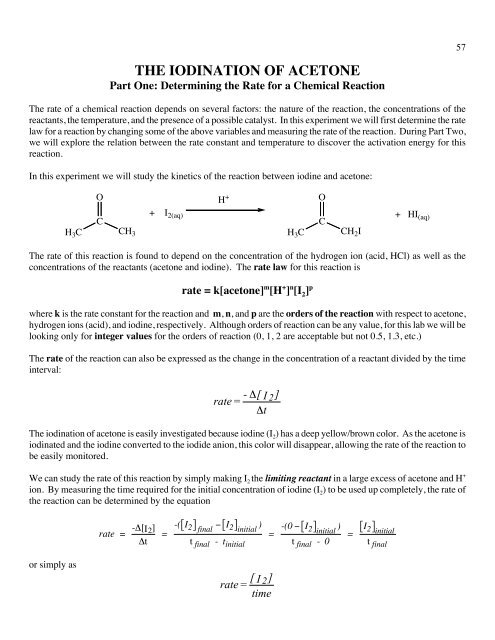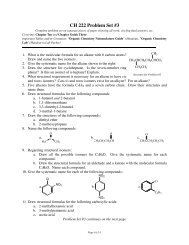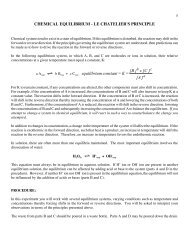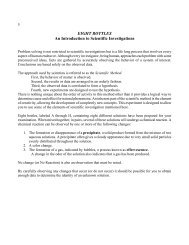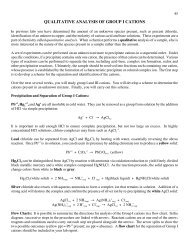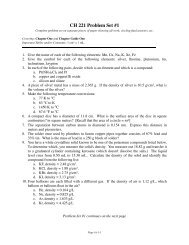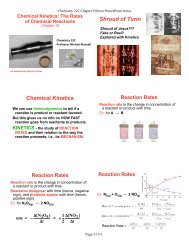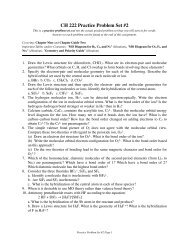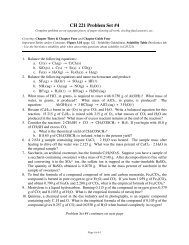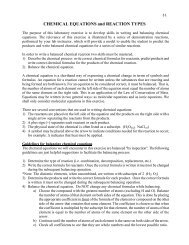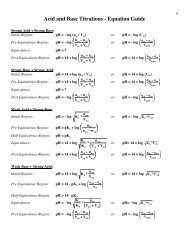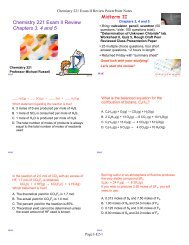Iodination of Acetone (Part I)
Iodination of Acetone (Part I)
Iodination of Acetone (Part I)
Create successful ePaper yourself
Turn your PDF publications into a flip-book with our unique Google optimized e-Paper software.
58From the rate information we can determine the orders with respect to acetone (m), acid (n) and iodine (p) byvarying the amounts <strong>of</strong> reactants and measuring the effect on the rate. Once the orders <strong>of</strong> reaction are known, wewill be able to calculate the rate constant, k. In <strong>Part</strong> One <strong>of</strong> this experiment you will determine the rates <strong>of</strong>reactions, the orders <strong>of</strong> the reactants, and finally the rate constant at room temperature.Procedure: Finding the rate, orders <strong>of</strong> reaction and rate constant, k at room temperatureFor each trial listed below: measure out the appropriate quantities <strong>of</strong> 1.0 M HCl, 4.0 M acetone and water using a10.00 mL graduated cylinder and place them in a 125 mL flask. Making sure not to spill any on your hands orclothes, measure out the appropriate amount <strong>of</strong> 0.0050 M iodine in a 10.00 mL flask (Note: use these concentrationvalues in this lab regardless <strong>of</strong> what the stockroom lists as the actual concentration.) Start the stopwatch as you addthe iodine to the 125 mL flask. Swirl the flask (which helps to prevent acetone evaporation) until the yellow colordisappears, then halt the stopwatch. It may help to place the flask on a white piece <strong>of</strong> paper to help discern when thecolor disappears. Record the time elapsed in seconds. Repeat this reaction mixture until two trials are within 20seconds <strong>of</strong> each other. Determine the average time elapsed in seconds for this trial.Repeat this process for each <strong>of</strong> the four trials listed in the table below.Trial HCl (mL) <strong>Acetone</strong> (mL) I 2 (mL) Water (mL) Total Volume (mL)1 5 5 5 10 25.002 5 5 10 5 25.003 5 10 5 5 25.004 10 5 5 5 25.00Calculations:1. Determine the concentration <strong>of</strong> each reactant (acetone, HCl and iodine) in each reaction mixture.Example: Determine the concentration <strong>of</strong> iodine in trial #1.Solution: Using the relation M 1 V 1 = M 2 V 2 let M 1 = initial (undiluted) concentration <strong>of</strong> iodine (0.0050 M), V 1= 5.00 mL (<strong>of</strong> undiluted iodine added to the mixture), and V 2 = 25.00 mL (the total volume <strong>of</strong> the dilutedsolution once HCl, acetone and water are added). Solving for M 2 , the concentration <strong>of</strong> iodine in the dilutedsolution, one gets:M 2 = 0.0050 M * 5.00 mL / 25.00 mL = 0.0010 M, which is the concentration <strong>of</strong> iodine used in thereaction in trial #1.Example: Determine the concentration <strong>of</strong> iodine in trial #2.Solution: Since M 1 and V 2 are the same as in the previous example, we see that only V 1 has changed to
5910.00 mL. Rearranging for M 2 as before:M 2 = 0.0050 M * 10.00 mL / 25.00 mL = 0.0020 M, the concentration <strong>of</strong> iodine used in the reactionin trial #2.2. Average each pair <strong>of</strong> times for each trial then calculate the rate <strong>of</strong> the reaction.Example: Trial #1 required an average <strong>of</strong> 240 seconds to go to completion. Trial #2 required an average <strong>of</strong>496 seconds to go to completion. Find the rate <strong>of</strong> reaction for both trial #1 and trial #2.Solution: The rate <strong>of</strong> reaction is equal to the concentration <strong>of</strong> iodine divided by the time elapsed (see theintroduction section for more details; do not use [HCl]/time or [acetone]/time in this lab). Using theconcentrations from the above examples, we can calculate rate thusly:rate (trial #1) = [I 2 ]/(average time in seconds) = 0.0010 M / 240 s = 4.2 * 10 -6 M s -1 .rate (trial #2) = [I 2 ]/(average time in seconds) = 0.0020 M / 496 s = 4.0 * 10 -6 M s -1 .3. Next determine the order <strong>of</strong> the reaction with respect to each reactant (m, n, and p). Show your work clearly inyour lab report as to how you solved for m, n and p.€€Example: Find the order <strong>of</strong> reaction with respect to iodine (p) using the information calculated above.Solution: Notice how in trial #2 we doubled the concentration <strong>of</strong> [I 2 ] while leaving the other reactants'concentrations (HCl, acetone) unchanged. An effect upon the rate <strong>of</strong> the reaction will reflect the influence<strong>of</strong> the iodine only, and this will allow us to determine p.In these sample calculations, doubling the concentration <strong>of</strong> iodine (to 0.0020 M from 0.0010 M) spawned anegligible change in the rate (4.0 * 10 -6 M s -1 versus 4.2 * 10 -6 M s -1 ). Because we are only concerned withwhole integer values <strong>of</strong> rate orders, this implies a zero order reactant, and p = 0.A more formal approach to determining p would be as follows: divide the expression for rate 2 by theexpression for rate 1; this results in the following:rate 2rate 1 = k[acetone]m [HCl] n [I 2 ] pk[acetone] m [HCl] n [I 2 ] pThe values <strong>of</strong> k, [acetone] and [HCl] remain constant between trial 1 and trial 2 (only [I 2 ] changes), so theexpression reduces torate 2rate 10.95 = (2) p4.0 * 10-6 [0.0020]p= =-64.2 * 10 [0.0010] p = 2 p
60Taking the logarithm <strong>of</strong> both sides leads tolog 0.95 = log 2 p = p log 2and solving for p:p =log 0.95log 2= - 0.074 ≈ 0Therefore, the order with respect to iodine equals zero.4. Calculate € k for each trial.Example: Find the value <strong>of</strong> k for trial #1 using the values supplied above and assuming that the order withrespect to acetone (m) is one and the order with respect to HCl (n) is one.Solution: Using the information in trial #1, the diluted concentration <strong>of</strong> acetone is 0.80 M and the HCl is0.20 M (confirm this on your own). Using the values for rate 1 and the order <strong>of</strong> iodine from above, we cancalculate k from the following equation:rate = k[acetone] m [HCl] n [I 2 ] p4.2 * 10 -6 = k[0.80] 1 [0.20] 1 [0.0010] 0€and solving for k we get a value <strong>of</strong> k = 2.6 * 10 -5 M -1 s -15. Find € the average value <strong>of</strong> k and conduct a parts per thousand analysis on your k values.POSTLAB QUESTIONS:1. In a reaction involving the iodination <strong>of</strong> acetone, the following reaction mixture was used: 5.00 mL 4.0 Macetone, 5.00 mL 1.0 M HCl, 5.00 mL 0.0050 M I 2 , and 10.0 mL water.a. What was the molarity <strong>of</strong> the acetone in the reaction mixture? (Recall that M 1 V 1 = M 2 V 2 )b. The color <strong>of</strong> the above reaction mixture disappeared in 250 seconds. What was the rate <strong>of</strong> the reaction?(Hint: First determine the initial concentration <strong>of</strong> the iodine.)2. A second reaction mixture was made: 10.00 mL acetone, 5.00 mL HCl, 5.00 mL I 2 , and 5.00 mL <strong>of</strong> H 2 O.a. What was the molarity <strong>of</strong> the acetone in this reaction mixture?b. The iodine color disappeared in 120 seconds. What was the rate <strong>of</strong> the reaction?c. Determine the order <strong>of</strong> the reaction (m) with respect to acetone using the information from question 1 and 2.(Round <strong>of</strong>f the value <strong>of</strong> m to the nearest integer)3. A third reaction mixture is made: 10.00 mL acetone, 5.00 mL HCl, 10.00 mL I 2 . If the reaction is zero orderwith respect to iodine, how long will it take for the iodine color to disappear?


